Abstract
Purpose
To report an immunocompetent patient with more than 1-year survival after treatment with voriconazole, despite invasive paranasal sinus aspergillosis involving the orbital apex.
Case summary:
A 74-year-old woman with only preexisting hypertension visited our clinic complaining of pain and immovable left eye that occurred approximately 4 days prior. Computed tomography (CT) and magnetic resonance imaging (MRI) showed a sphenoid sinusitis with suspicious lesion involving the orbital apex of the left eye. A biopsy by functional endoscopic sphenoid surgery (FESS) was performed through the sphenoid sinus, which enabled us to diagnose aspergillosis. The patient had esotropia, ophthalmoplegia, positive RAPD, and ptosis in the left eye. On follow-up, a new MRI showed acute to subacute stage infarction at the left occipital lobe. After the patient was treated with intravenous voriconazole, ptosis, and ophthalmoplegia improved. At the 13-month follow-up, she was alive with no disease recurrence.
References
1. Shamim MS, Siddiqui AA, Enam SA, et al. Craniocerebral aspergillosis in immunocompetent hosts: surgical perspective. Neurol India. 2007; 55:274–81.

2. Kim DG, Hong SC, Kim HJ, et al. Cerebral aspergillosis in immunologically competent patients. Surg Neurol. 1993; 40:326–31.

3. Myoken Y, Sugata T, Kyo TI, Fujihara M. Pathological features of invasive oral aspergillosis in patients with hematologic malignancies. J Oral Maxillofac Surg. 1996; 54:263–70.
4. Alrajhi AA, Enani M, Mahasin Z, Al-Omran K. Chronic invasive aspergillosis of the paranasal sinuses in immunocompetent hosts from Saudi Arabia. Am J Trop Med Hyg. 2001; 65:83–6.

5. Lee DC, Lee JH, Choi WS. A case of the sino-orbital-cerebral aspergillosis. J Korean Ophthalmol Soc. 1999; 40:1678–83.
6. Aisner J, Schimpff SC, Bennett JE, et al. Aspergillus infection in cancer patients. Association with fireproofing materials in a new hospital. JAMA. 1976; 235:411–2.
7. Sivak-Callcott JA, Livesley N, Nugent RA, et al. Localised invasive sino-orbital aspergillosis: characteristic features. Br J Ophthalmol. 2004; 88:681–7.

8. Groll AH, Shah PM, Mentzel C, et al. Trends in the postmortem epidemiology of invasive fungal infections at a university hospital. J Infect. 1996; 33:23–32.

9. Miyabe S, Koizuka I, Ochi K, et al. Two cases of Aspergillus sinusitis with bone destruction. Auris Nasus Larynx. 2003; 30:S115–21.

10. Johnson TE, Casiano RR, Kronish JW, et al. Sino-orbital aspergil-losis in acquired immunodeficiency syndrome. Arch Ophthalmol. 1999; 117:57–64.

11. Chopra H, Dua K, Malhotra V, et al. Invasive fungal sinusitis of isolated sphenoid sinus in immunocompetent subjects. Mycoses. 2006; 49:30–6.

12. Siddiqui AA, Shah AA, Bashir SH. Craniocerebral aspergillosis of sinonasal origin in immunocompetent patients: clinical spectrum and outcome in 25 cases. Neurosurgery. 2004; 55:602–11. discussion 611-3.

13. Wipfler P, Pilz G, Golaszewski S, et al. Invasive aspergillosis presenting with a painless complete ophthalmoplegia. Clin Neurol Neurosurg. 2010; 112:85–7.

14. Siddiqui AA, Bashir SH, Shah AA, Enam SA. Complications in craniocerebral aspergillosis of sino-nasal origin in immunocompetent patients. Pan Arab journal of neurosurgery : official journal of Pan Arab Neurosurgical Society. 2010; 14:99–103.
15. Gupta AK, Mann SB, Khosla VK, et al. Non-randomized comparison of surgical modalities for paranasal sinus mycoses with intracranial extension. Mycoses. 1999; 42:225–30.
16. Streppel M, Bachmann G, Arnold G, et al. Successful treatment of an invasive aspergillosis of the skull base and paranasal sinuses with liposomal amphotericin B and intraconazole. Ann Otol Rhinol Laryngol. 1999; 108:205–7.
17. Espinel-Ingroff A, Boyle K, Sheehan DJ. In vitro antifungal activities of voriconazole and reference agents as determined by NCCLS methods: review of the literature. Mycopathologia. 2001; 150:101–15.
Figure 1.
At the initial visit, the patient had 30 prism diopters of left esodeviation (E). There was limitation of elevation (A, B, C) and abduction (F) in the left eye.
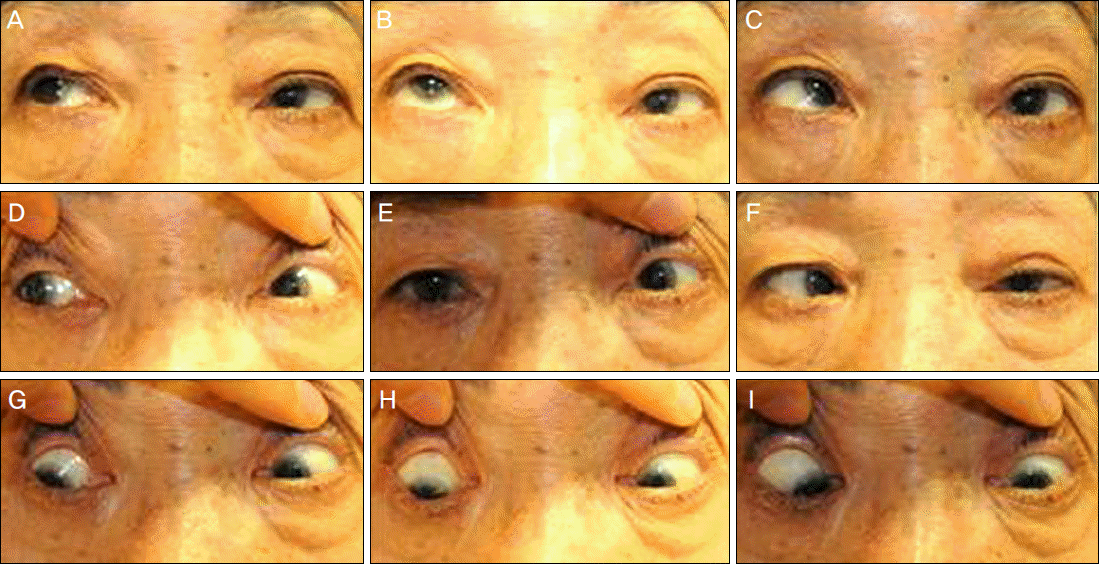
Figure 3.
Magnetic resonance images (Axial view) showing invasive aspergillosis involving left ethmoid and sphenoid sinuses, left anterior clinoid process, left orbital apex with bony disruption, and lateral and superior wall of the left sphenoid sinus (A). Acute to subacute stage infarction, left occipital lobe (PCA territory) (B).
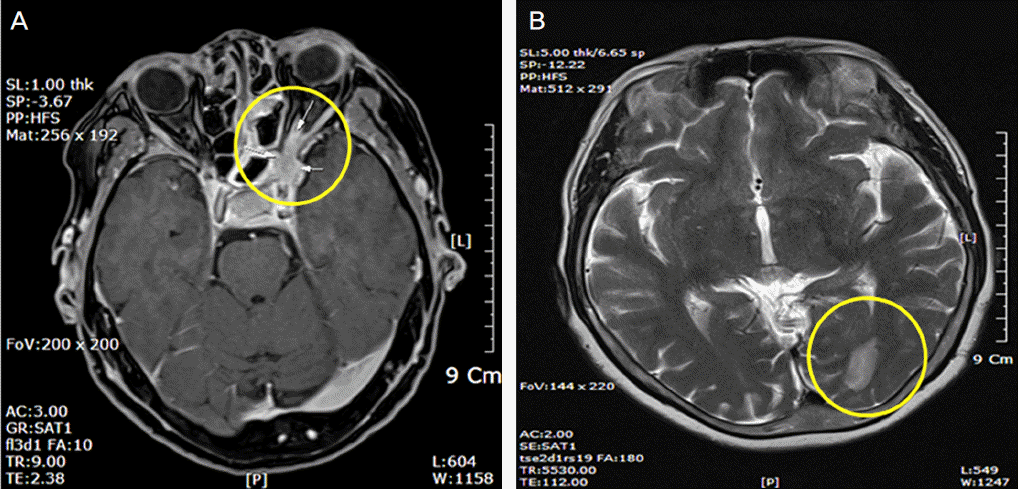




 PDF
PDF ePub
ePub Citation
Citation Print
Print


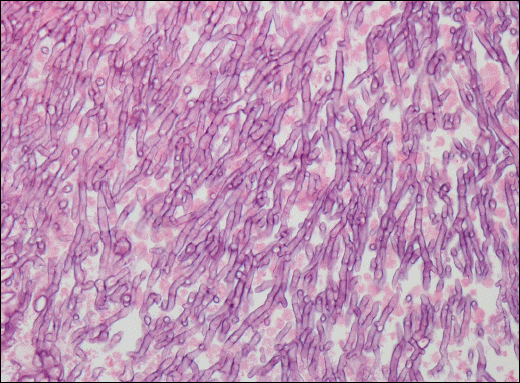
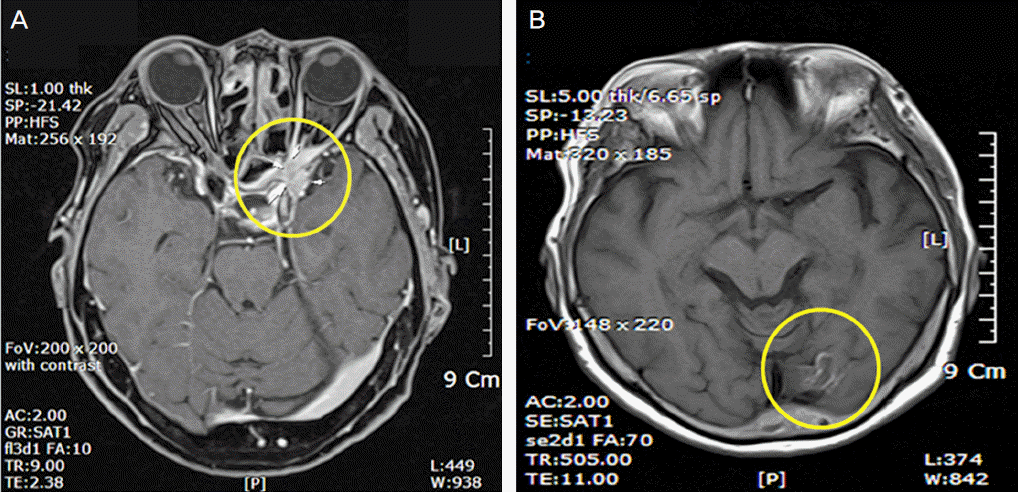
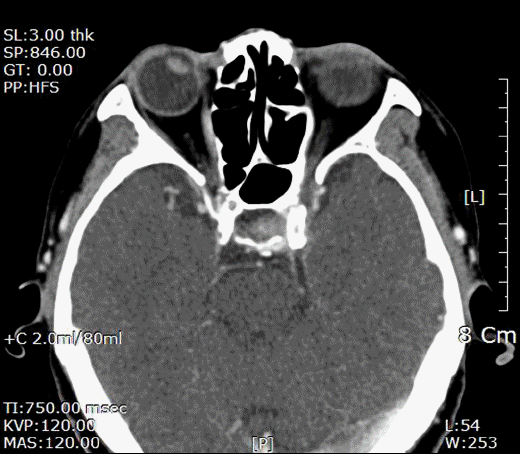
 XML Download
XML Download